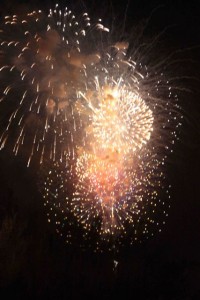Playing With Wolfgang: Suites for the 4th!
 I count myself very lucky that my undergrad teacher passed his love of 20th Century American music down to me. He himself had studied with Johana Harris at Colorado Springs and always maintained that the summers, when premier mid-century American composers would come to work, play, teach, and commune with each other, were the best part of his time there. He would have been heartbroken to see the devastation there now. I know everyone’s heart goes out to all of you affected by the forest fires.
I count myself very lucky that my undergrad teacher passed his love of 20th Century American music down to me. He himself had studied with Johana Harris at Colorado Springs and always maintained that the summers, when premier mid-century American composers would come to work, play, teach, and commune with each other, were the best part of his time there. He would have been heartbroken to see the devastation there now. I know everyone’s heart goes out to all of you affected by the forest fires.
Under his tutelage, I discovered the Dello Joio Suite for Piano. I had never played any purely American music before, except for musical theater scores in high school, but I found that the sounds and emotions were in my blood- literally of the sound of my growing up. Nearly 20 years later, I connected in the same way with Copland’s Four Piano Blues.
So, In honor of Independence Day, I offer you some suites and small sets of pieces by American composers (in no particular order). Over the years, I have had judges remark that they were unfamiliar with but intrigued by several of these works. Once, a concert artist from Eastern Europe was so fascinated by the Dello Joio Suite that he gave my student nearly an hour masterclass as they discovered it together. She was thrilled when he told her, “This is going into my repertoire!”
Enjoy and Happy 4th Everyone!
Norman Dello Joio
Suite for Piano(1940) / Salute to Scarlatti
J. Nathaniel Dett
In The Bottoms (contains the famous Juba Dance)
Roy Harris
Little Suite for Piano (1938) / Suite for Piano / American Ballads
Ernest Bloch
Aaron Copland
Paul Hindemith
Ernest Krenek
Peter Mennin
Roger Sessions
William Grant Still
Leon Kirchner
John Harbison
Four Occasional Pieces / Four More Occasional Pieces
Robert Muczynski
Samuel Coleridge-Taylor
Gottschalk wrote a lot of very pleasing and colorful if not very deep piano music. Deep has its place, but not every moment is a Bach organ moment, and this is wonderful music when you want to relax to something light. Gottschalk drew on African American and American Folk influences as well as his formal training in Paris to produce a new sound for the mid nineteenth century. Not really classical, but not yet with the structure or sophistication of the later rag and jazz, it’s really just Gottschalk. I first encountered Amiram Rigai playing this music years ago on a Musical Heritage Society cassette. A lot of pianists have done credible recordings of Gottschalk, but to me this is how his pieces should sound. This is a terrific CD.